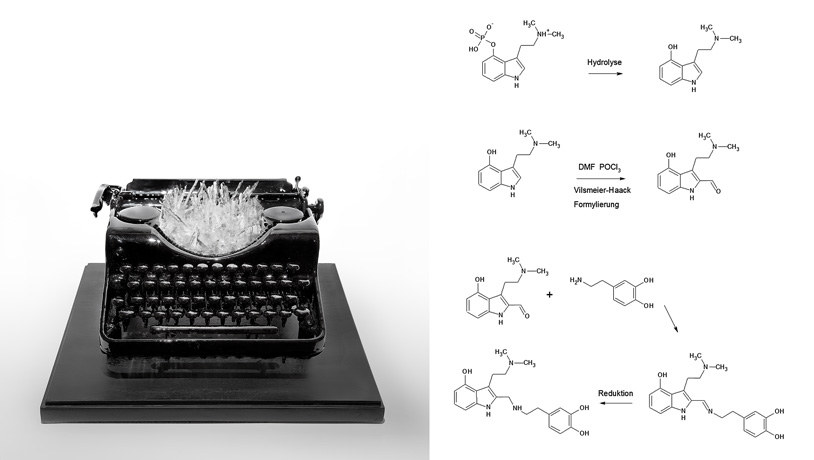
left: PSILOPROSE, 2015
Crystalline psilamine, steel, epoxy resin, acrylic glass case, 35 x 39 x 37 cm
right: chemical pathway for PSILAMIN by Ingo Wartusch
A crystalline form of PSILAMIN grows from the type wheel.
The project PSYCHOPROSA uses biochemical processes as artistic expression and creates an installation at the interface of art and scientific experimental set-up. It transforms the rooms into a coherent ensemble of greenhouse, laboratory, cooling chamber and factory.
At the beginning we find a greenhouse in which algae and fungi are cultivated. These organic materials are pumped into glass sculptures where chemical processes produce a synthetic hallucinogen: the resulting molecule is PSILAMIN which has never been present in a natural context before. The remaining biomass of algae and fungi is a slimy material that develops a viscous consistency after heating, cooling and mixing: Thick threads and veils form transparent, liquid sculptures. If we were to consume the molecular sculpture PSILAMIN, solid objects would melt and begin to flow in our perception. The psychotropic effect of the hallucinogenic substance is reflected in the exhibition as a real process.
Crystalline psilamine, steel, epoxy resin, acrylic glass case, 35 x 39 x 37 cm
right: chemical pathway for PSILAMIN by Ingo Wartusch
A crystalline form of PSILAMIN grows from the type wheel.
The project PSYCHOPROSA uses biochemical processes as artistic expression and creates an installation at the interface of art and scientific experimental set-up. It transforms the rooms into a coherent ensemble of greenhouse, laboratory, cooling chamber and factory.
At the beginning we find a greenhouse in which algae and fungi are cultivated. These organic materials are pumped into glass sculptures where chemical processes produce a synthetic hallucinogen: the resulting molecule is PSILAMIN which has never been present in a natural context before. The remaining biomass of algae and fungi is a slimy material that develops a viscous consistency after heating, cooling and mixing: Thick threads and veils form transparent, liquid sculptures. If we were to consume the molecular sculpture PSILAMIN, solid objects would melt and begin to flow in our perception. The psychotropic effect of the hallucinogenic substance is reflected in the exhibition as a real process.